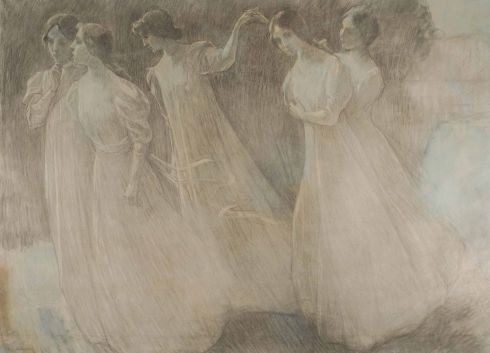“Death is not extinguishing the light; it is only putting out the lamp because the dawn has come.”
(Tagore)
 Jakub Schikaneder, Dead Girl, 1909
Jakub Schikaneder, Dead Girl, 1909
Czech painter Jakub Schikaneder’s paintings are full of figures of people miserable in one way or another. He painted the poor and the lonely, the forgotten and the downtrodden, old and frail, young and – dead. Motif of death appears often in Schikaneder’s art; from a scene of murder to a melancholy figure of a drowned young girl washed a shore and in this painting, “Dead Girl”, painted in 1909 the lightness and innocence of youth are touched and torn by death’s black claws. The scene is bared to the minimum, nothing unnecessary clutters the composition, just a chair and a bed made out of dark wood; the wood is solid, dark and hard, and the girl is frail and clad in white. A humble interior. A little room filled with sickness and death, stuffy from the coughs and the burning candle. That way, the painter placed our focus on the real essence of the painting; the girl and her death. Death is an invisible and pervading, solemn and mysterious character in this poignant scene. The simplicity adds to the sorrowful mood of the painting and the colour palette of different tones of grey, the colour of fog and ashes, because the world of colours, sounds and scents means nothing to her anymore. You are fading away, sweet child, and:
“….You will no longer
Distinguish what rises or falls;
Colors are closed, and tones are empty,
And you won’t even know any longer
Who brings you all the flowers.“
I also stumbled upon this photograph by a Polish photographer Laura Makabresku and it is obviously inspired by this painting and is equally melancholy and poignant. Edvard Munch also painted a sick child in bed and it seems that the motif of death and children go well together because they create a contrast which makes it especially poignant and sorrowful.

Photograph by Laura Makabresku

Jakub Schikaneder, By the Girl’s Bed, 1910
All of Jakub Schikaneder’s paintings have that particular mood which is hard to put in words, but rather brings to mind other imagery; the thick and impenetrable November fog, orange autumnal sunset tinged with sadness because it seems the sun will never rise again, a soil hardened by frost, an eerie yellowish light of the lantern on the street corner. Autumnal and announcing death and the end. Schikaneder also loved the motif of autumn and winter, and is not winter the death of nature? In another painting, “By the Girl’s Bed”, painted the following year Schikaneder explores the same motif; death of a young girl. In this painting the glow of the candle is overpowering, colouring the room in warm orange shades, as if the more frail and sickly the girl is, the more strength the candle possesses.





